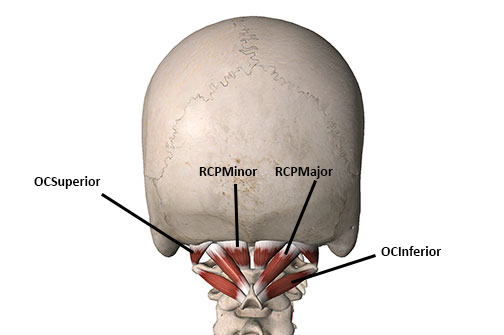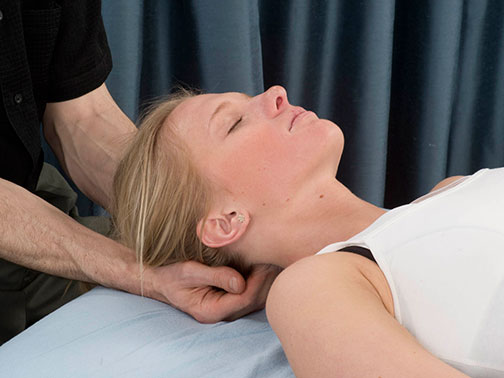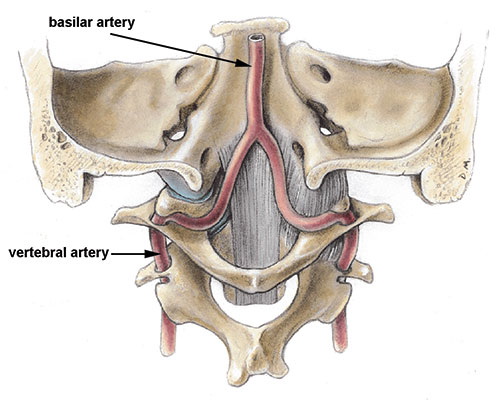Safely Working the Suboccipital Muscles
- Whitney Lowe
The suboccipital muscles in the cervical region often contribute to chronic neck and headache pain. These muscles are frequently under postural strain due to common daily activities, such as forward head posture from prolonged computer use. Traumatic injuries, such as whiplash from a car accident, can also significantly impact these muscles.
The suboccipital muscles are a key group responsible for controlling motion between the cervical spine and the head. This group consists of four short muscles on each side of the neck: the rectus capitis posterior minor, rectus capitis posterior major, obliquus capitis superior, and obliquus capitis inferior (Image 1).

Despite their small size, trigger points and hypertonicity in the suboccipital muscles are often associated with various neck and head pain complaints. Additionally, the rectus capitis posterior minor has a fascial connection to the dura mater. Adverse tension in this muscle can transmit tensile forces to the dura mater, a richly innervated neurological tissue, potentially contributing to pain.
The suboccipital muscles are located deep beneath other posterior cervical muscles, such as the upper trapezius and semispinalis capitis, making them difficult to access. Due to their short length, long gliding strokes on them are not possible. Consequently, most treatment techniques focus on static compression with minimal movement.
One of the most common ways to treat the suboccipital muscles is through fingertip compression at the base of the occiput, where these muscles span the atlanto-occipital joint (Image 2). This technique is typically performed by applying pressure with both hands into the suboccipital region as the client’s head rests on the fingertips. While this method effectively relieves tension, it is important to observe certain precautions when using a technique or approach like this.

The vertebral arteries, which run along each side of the spine, travel through the suboccipital region and enter the cranium, where they join to form the basilar artery (Image 3).

Since individual anatomy can vary, applying pressure in the suboccipital region can sometimes compress the vertebral arteries, potentially reducing blood flow to the brain. This reduction in blood flow, known as vertebrobasilar insufficiency, is an adverse outcome, even if it temporarily alleviates muscle tightness.
Symptoms of vertebrobasilar insufficiency can vary but typically include:
- Dizziness or Vertigo: A sudden spinning sensation or loss of balance.
- Visual Disturbances: Blurred vision, double vision (diplopia), or loss of vision in one or both eyes.
- Nausea and Vomiting: Often associated with dizziness or vertigo.
- Headaches: Particularly at the back of the head (occipital region).
- Numbness or Tingling: Often affecting the face, limbs, or both.
- Weakness or Clumsiness: Difficulty with coordination or sudden weakness in the limbs.
- Difficulty Speaking: Slurred speech (dysarthria) or difficulty finding words.
It may be difficult to recognize some of these symptoms during treatment because the client is lying quietly on the table. That is why it is valuable to check in with them in advance and remind them to tell you if they have any unusual symptoms while you are working in this area.
To minimize the risk of complications from compressing the vertebral arteries, it is advisable to apply pressure to the suboccipital muscles only on one side at a time (Image 4).

Applying pressure to one side of the suboccipital region at a time helps maintain arterial circulation, ensuring that blood flow remains unobstructed on the opposite side during treatment. Although adverse reactions from pressure in this area are rare, they can be alarming for the client when they do occur, so it is essential to remain aware of this potential complication. Using a variety of techniques while treating one side at a time is a safer and effective approach.
You can learn much more about treating the suboccipital region and numerous other cervical complaints in our orthopedic medical massage courses. Come join us and make a huge difference in your client’s lives!

